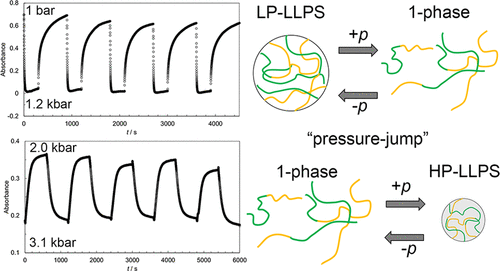当前位置:
X-MOL 学术
›
J. Am. Chem. Soc.
›
论文详情
Our official English website, www.x-mol.net, welcomes your
feedback! (Note: you will need to create a separate account there.)
Pressure-Jump Kinetics of Liquid–Liquid Phase Separation: Comparison of Two Different Condensed Phases of the RNA-Binding Protein, Fused in Sarcoma
Journal of the American Chemical Society ( IF 14.4 ) Pub Date : 2021-11-17 , DOI: 10.1021/jacs.1c07571 Ryo Kitahara 1 , Ryota Yamazaki 1 , Fumika Ide 2 , Shujie Li 3 , Yutaro Shiramasa 1 , Naoya Sasahara 2 , Takuya Yoshizawa 2
Journal of the American Chemical Society ( IF 14.4 ) Pub Date : 2021-11-17 , DOI: 10.1021/jacs.1c07571 Ryo Kitahara 1 , Ryota Yamazaki 1 , Fumika Ide 2 , Shujie Li 3 , Yutaro Shiramasa 1 , Naoya Sasahara 2 , Takuya Yoshizawa 2
Affiliation

|
The RNA-binding protein fused in sarcoma (FUS) undergoes liquid–liquid phase separation (LLPS) both in vivo and in vitro. Self-assembled liquid droplets of FUS transform into reversible hydrogels and into more irreversible and toxic aggregates. Although LLPS can be a precursor of irreversible aggregates, a generic method to study kinetics of the formation of LLPS has not been developed. Here, we demonstrated the pressure-jump kinetics of phase transition between the 1-phase state and FUS-LLPS states observed at low pressure (<2 kbar, LP-LLPS) and high pressure (>2 kbar, HP-LLPS) using high-pressure UV/vis spectroscopy. Absorbance (turbidity) changes were reproduced repeatedly using pressure cycles. The Johnson–Mehl–Avrami–Kolmogorov theory was used to understand droplet formation occurring via nucleation and growth. The Avrami exponent n, representing the dimensionality of growing droplets, and the reaction rate constant k were calculated. The HP-LLPS formation rate was ∼2-fold slower than that of LP-LLPS. The Avrami exponent obtained for both LLPS states could be explained by diffusion-limited growth. Nucleation and growth rates decreased during LP-LLPS formation (n = 0.51), and the nucleation rate decreased with a constant growth rate in HP-LLPS formation (n = 1.4). The HP-LLPS vanishing rate was ∼20-fold slower than that of LP-LLPS. This difference in vanishing rates indicates a stronger intermolecular interaction in HP-LLPS than in LP-LLPS, which might promote transformation into irreversible aggregates in the droplets. Further, direct transition from HP-LLPS to LP-LLPS was observed. This indicates that interconversion between LP-LLPS and HP-LLPS occurs in equilibrium. Formation of reversible liquid droplets, followed by phase transition into another liquid phase, could thus be part of the physiological maturation process of FUS-LLPS.
中文翻译:

液-液相分离的压力跳跃动力学:在肉瘤中融合的 RNA 结合蛋白的两种不同凝聚相的比较
肉瘤中融合的 RNA 结合蛋白 (FUS)在体内和体外都经历了液-液相分离 (LLPS). FUS 的自组装液滴转化为可逆水凝胶和更不可逆和有毒的聚集体。尽管 LLPS 可能是不可逆聚集体的前体,但尚未开发出研究 LLPS 形成动力学的通用方法。在这里,我们展示了在低压(<2 kbar,LP-LLPS)和高压(>2 kbar,HP-LLPS)下观察到的一相状态和 FUS-LLPS 状态之间相变的压力跳跃动力学,使用高-压力紫外/可见光谱。使用压力循环重复再现吸光度(浊度)变化。Johnson-Mehl-Avrami-Kolmogorov 理论用于理解通过成核和生长发生的液滴形成。Avrami 指数n,代表液滴生长的维数,以及反应速率常数k被计算出来。HP-LLPS 的形成速率比 LP-LLPS 慢 2 倍。对于两种 LLPS 状态获得的 Avrami 指数可以用扩散限制生长来解释。LP-LLPS 形成过程中成核率和生长率下降(n = 0.51),HP-LLPS 形成过程中成核率随着恒定增长率而下降(n= 1.4)。HP-LLPS 的消失率比 LP-LLPS 慢 20 倍。这种消失率的差异表明 HP-LLPS 中的分子间相互作用比 LP-LLPS 中更强,这可能会促进液滴中向不可逆聚集体的转变。此外,观察到从 HP-LLPS 到 LP-LLPS 的直接转变。这表明 LP-LLPS 和 HP-LLPS 之间的相互转换发生在平衡状态。因此,可逆液滴的形成,然后是相变到另一个液相,可能是 FUS-LLPS 生理成熟过程的一部分。
更新日期:2021-12-01
中文翻译:

液-液相分离的压力跳跃动力学:在肉瘤中融合的 RNA 结合蛋白的两种不同凝聚相的比较
肉瘤中融合的 RNA 结合蛋白 (FUS)在体内和体外都经历了液-液相分离 (LLPS). FUS 的自组装液滴转化为可逆水凝胶和更不可逆和有毒的聚集体。尽管 LLPS 可能是不可逆聚集体的前体,但尚未开发出研究 LLPS 形成动力学的通用方法。在这里,我们展示了在低压(<2 kbar,LP-LLPS)和高压(>2 kbar,HP-LLPS)下观察到的一相状态和 FUS-LLPS 状态之间相变的压力跳跃动力学,使用高-压力紫外/可见光谱。使用压力循环重复再现吸光度(浊度)变化。Johnson-Mehl-Avrami-Kolmogorov 理论用于理解通过成核和生长发生的液滴形成。Avrami 指数n,代表液滴生长的维数,以及反应速率常数k被计算出来。HP-LLPS 的形成速率比 LP-LLPS 慢 2 倍。对于两种 LLPS 状态获得的 Avrami 指数可以用扩散限制生长来解释。LP-LLPS 形成过程中成核率和生长率下降(n = 0.51),HP-LLPS 形成过程中成核率随着恒定增长率而下降(n= 1.4)。HP-LLPS 的消失率比 LP-LLPS 慢 20 倍。这种消失率的差异表明 HP-LLPS 中的分子间相互作用比 LP-LLPS 中更强,这可能会促进液滴中向不可逆聚集体的转变。此外,观察到从 HP-LLPS 到 LP-LLPS 的直接转变。这表明 LP-LLPS 和 HP-LLPS 之间的相互转换发生在平衡状态。因此,可逆液滴的形成,然后是相变到另一个液相,可能是 FUS-LLPS 生理成熟过程的一部分。











































 京公网安备 11010802027423号
京公网安备 11010802027423号